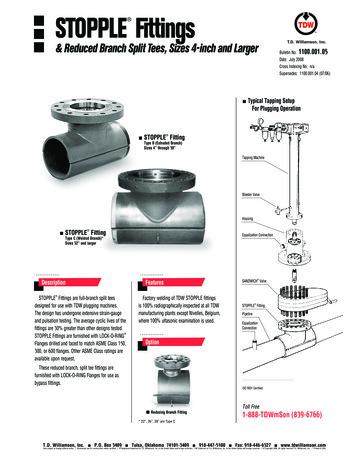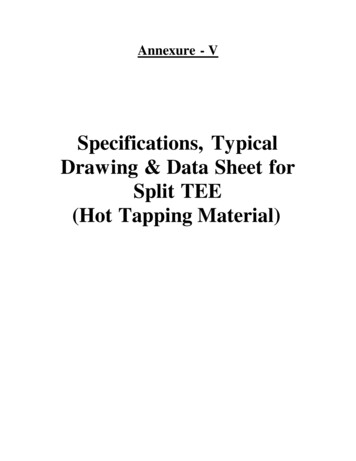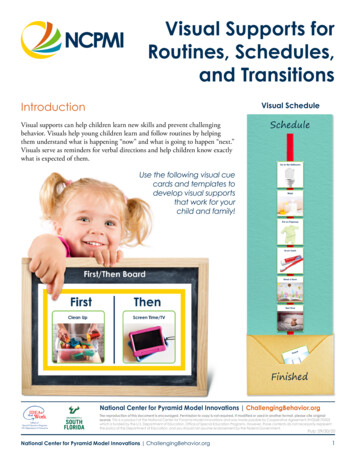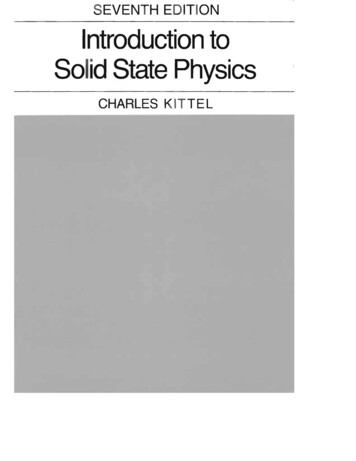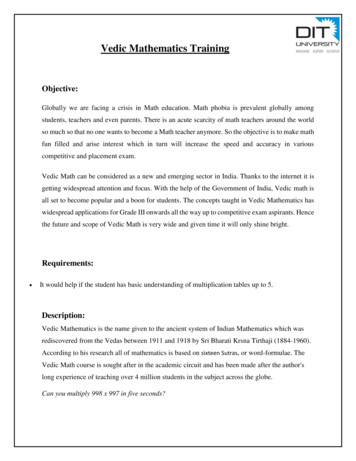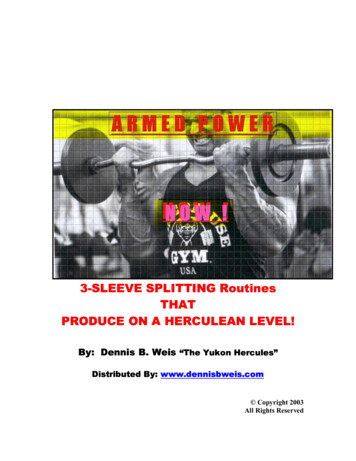
Transcription
3-SLEEVE SPLITTING RoutinesTHATPRODUCE ON A HERCULEAN LEVEL!By: Dennis B. Weis “The Yukon Hercules”Distributed By: www.dennisbweis.com Copyright 2003All Rights Reserved
Insights and ExpressionsIt is a well known fact that beginners to advanced amateur bodybuildersconsider HUGE and SUPERIOR iron clad arm development to be the badgeof one’s bodybuilding achievements, and especially to the casual onlooker.Here’s a prime example of this. I can’t remember the last time someoneasked me “How big is your chest?” or “How big are your thighs?” But yetit has been a frequent occurrence, to have people ask “How big are yourarms?”I know when I was a teenager and interested in bodybuilding, my armswere the only way to show-off my muscles. My preference and attitude wasto bulk-up my arms to massive proportions, and I always wore tight shortsleeved shirts so everyone couldn’t help but gaze at my “well-muscledmanly arms. . . .”As time went on and I stepped into my 20’s I learned that HUGE andSUPERIOR arm development should always compliment total physiquedevelopment and symmetry.For example you should never try to develop an 18” upper arm whenyour chest is only 40 inches in circumference, or your thighs are smallerthan 26 inches. The same can be said of all muscle groups—the thighsshould not be developed at the expense of the calves, or the chest at theexpense of the legs and so on.Total body development should become the ultimate training endeavorof all bodybuilders. Please make a point to remember this as you embarkupon the “3” training programs presented in this arm development ereport.OK, here’s the Sleeve Splitting ARMED POWER NOW! Routine. . . .2
No. 1The Revolutionary‘Two and One’ Arm Training TechniqueOne of the paramount problems many bodybuilders face whenembarking upon an exclusive exercise program(s) outlined in varioushardcore bodybuilding books, courses or magazines is this. The exerciseslisted in a particular workout program sometimes require different piecesof expensive exercise equipment. For example when training the arms youmight be required to have a Scott preacher bench (for curling movements)and a Lat machine (for tricep pushdowns) and so forth.I don’t think it would be any stretch of the imagination to say that manyof you don’t have the luxury of Gold’s, Worlds or Powerhouse Gym (whichincludes the training equipment mentioned) in your town. Furthermore ifyou happen to be training in a home gym, chances are it may not beoutfitted with some of the more exotic and expensive pieces of trainingequipment.It is with this thought in mind that I am going to outline a complete armtraining program which accesses the use of a few inexpensive trainingtools such as a Barbell/dumbbell combination, EZ curl bar, expandercables, (called Fabled Cables. Visit: www.ironmind.com or call1.916.265.6725 to order), and a couple of terry cloth towels.It doesn’t take magic to develop strong, sinewy and bulging arms thatlook, feel and produce on a Herculean level . . . ! So don’t be fooled by theminimal number of training tools I have mentioned, for they whencombined with the following singeing training program, will develop yourupper arms into a mountain fortress of thick, massive and impregnablesheaths of powerful chiseled granite like muscle.One program that I highly recommend is the revolutionary ‘Two and One’Arm Training Technique which was developed and popularized by aformer Jr. AAU Mr. America, Harry Smith.3
Here is the basic premise for performing this sleeve busting upper arm(biceps/ triceps) program.Beginning with the biceps, use a heavy bulk building type of exercisesuch as the Standing Two-Hands Strict Barbell Curl (using a straight bar).Begin by performing, two MAXIMUM INTENSITY SETS for 4-6 power-repseach, (using perfect form and motion). Take a one minute rest-pausebetween each of these two sets.Following the completion of the final rep of the second set (No restpause) immediately perform one set of 10-12 maxi-pump reps, with ashaping type exercise such as the Standing One-Arm DumbbellConcentration Curl. This completes one series of the modified “true”super-set (A series is termed modified because two sets of the heavy bulkbuilding exercise are performed prior to the shaping one. The term “true”refers to the two separate and distinct exercises used within the musclegroup) of the ‘Two and One’ program for the biceps.Depending upon your energy, endurance and sanity the modified “true”super-set for the biceps can be repeated for a total of 2 to 3 more series(always rest-pause 1.5 minutes between each series).Upon completion of the ‘Two and One’ Arm TrainingTechnique (3-4 series) program for the biceps, go on to the triceps. Forthis muscle group you might use a heavy bulk building type of exercisesuch as the Seated EZ-Bar French Press and the shaping exercise (to givea pump) could be the Isolated Triceps Pushups (described in text). Employthe same modified “true” super-set (sets, reps, rest-pauses) series protocolas described for the biceps.The following is an outline, only, of the ‘Two and One’ ArmTraining Technique. On pages 9-25 I will fully explain and illustratecorrect exercise performance. Please note in the outline that the bulk and4
shape exercises will change during select series but not the sets, reps andrest-pauses.BICEPS:Series #11. Standing Two-Hands Strict Barbell Curl1 set 4-6 repsRest-pause 1.0 minutes1 set 4-6 repsNo rest-pause, immediately do. . .2. Standing One-Arm Dumbbell Concentration Curl1 set .10-12 repsRest-pause 1.5 minutes and begin. . .Series #23. Same as exercise #14. Same as exercise #2Rest-pause 1.5 minutes and begin. . .Series #35. Wrist-Twist Barbell Curl1 set .4-6 repsRest-pause 1.0 minutes1 set .4-6 repsNo rest-pause, immediately do. . .6. Wrist-Twist Dumbbell Curls1 set 10-12 repsRest-pause 1.5 minutes and begin. . .Series #47. Same as exercise #58. Same as exercise #6A total of 12 sets for the biceps are completed.Rest-pause 1.5 minutes, then begin with the. . . .5
TRICEPS:Series #11. Seated EZ-Bar French Press1 set .4-6 repsRest-pause 1.0 minutes1 set 4-6 repsNo rest-pause, immediately do. . .2. Isolated Triceps Pushups1 set 10-12 repsRest-pause 1.5 minutes and begin. . .Series #23. Same as exercise #14. Same as exercise #2Rest-pause 1.5 minutes and begin. . .Series #35. Reverse Triceps Bench Dips1 set .4- 6 repsRest-pause 1.0 minutes1 set .4-6 repsNo rest-pause, immediately do. . .6. Expander-Cable ‘French’ Triceps Extension1 set ,,10-12 repsRest-pause 1.5 minutes and begin. . .Series #47. Same as exercise #58. Same as exercise #6A total of 12 sets for the triceps are completed.6
“6” Important PointsAbout The‘Two and One’ Arm Training Technique1. On the BULK type exercises (i.e. Standing Two-Hands Strict BarbellCurl, Wrist-Twist Barbell Curl, Bulk/Peak Barbell Curl, Seated EZ-BarFrench Press, Reverse Triceps Bench Dips and the substitute RearwardTriceps Extension Pushdowns), select a poundage (after specific warm-upsets are completed) which will allow you to perform 2 MAXIMUMINTENSITY SETS for 4 power-reps each, to positive failure.As your Biceps and Triceps strength increases in the BULK typeexercises and you are able to accomplish 6 power-reps per set with relativeease, then increase the amount of weight on the bar so that you can onlydo 4 power-reps. Use the double progression principle where you add arep every so often and then a poundage increase.2. The same training methodic applies to the SHAPING typeexercises (i.e. Standing One-Arm Dumbbell Concentration Curl, WristTwist Dumbbell Curl, Isolated Triceps Pushups, or substitute exercises:Expander-Cable ‘French’ Triceps Extension, and the Expander-Cable:Triceps ‘Cut’ Etcher), where you are doing 2 sets of 10 maxi-pump reps topositive failure.Again as your Biceps and Triceps strength increases and you are ableto accomplish 12 maxi-pump reps per set, increase the amount of weighton the bar so you can only do 10 maxi-pump reps. Use the DoubleProgression Principle and work up in reps and weight.3. Rest-pause one minute between each of the 2 MAXIMUM INTENSITYSETS for the chosen bulk exercise. Upon completion of the final rep of thesecond set, immediately, launch into the shaping exercise. This completesone series of the modified “true” super-set. Do a total of three to fourseries, rest-pausing 1.5 minutes between each series.4. “Technique-Emphasis” and rep cadence are of paramountimportance. Perform each and every rep s-l-o-w-l-y as opposed to doingthem ballistically. I recommend a rep seed ratio of 6/1/4; spend 6 secondsin the positive phase, 1 second of iso-tension at the completion of thepositive phase and 4 seconds in the negative phase of each rep. YOUMUST CONTROL THE WEIGHT, DON’T LET IT CONTROL YOU!7
5. Training frequency is an important consideration and the * ‘Twoand One’ Arm Training Technique can be structured into amodified Every-Other-Day SplitDay #1: Back, Chest, DeltsDay #3: *Biceps, *Triceps, ForearmsDay #5: Quads, Hamstrings, CalvesAnother variation of this split is the PUSH/PULLDay #1: Quads, Hamstrings, CalvesDay#3: Back, *BicepsDay #5: Chest, Delts, *TricepsDays #2, 4, 6 and 7 (Rest & Recuperation)6. Once you have been doing the ‘Two and One’ Arm TrainingTechnique for a while you will find many rep variations, I’m sure. Forexample, rather than doing the assigned 4-6 power-reps and the 10-12maxi-pump reps, you might choose instead to go with a 5/20 modified“true” super-set series. Here’s how it works.Begin a series by doing 2 MAXIMUM INTENSITY SETS for 5 power-repseach on the BULK exercise and 20 maxi-pump reps on the SHAPINGmovement. The options are virtually endless, but I recommend that youstay within the original guidelines of the ‘Two and One’ system.A Final Comment Just 4 to 6 weeks of hard work and dedication on this unusual butrewarding ‘Two and One’ arm training system will produce pleasing results.You’ll definitely notice a vein sculpturing thickening of the Biceps andTriceps and a more rugged appearance as well as new found ‘cuts’ and amore harmonious shape in the upper arms. Always remember to balanceupper arm development with some forearm work as well. (Note: The ‘Twoand One’ concept can be virtually applied to any muscle group)Do you think you can hang with the ‘Two and One’ ArmTraining Technique? You have all the tools. Stay flexed!!!8
‘Two and One’ Arm TrainingExercise “Technique-Emphasis”(Biceps)Standing Two-Hands Strict Barbell Curl (Bulk)This exercise in particular is a favorite among many of the previous topphysique champions, such as Bill Pearl, Boyer Coe, Lee Haney, and theyoungest Mr. America ever, Casey Viator. These and many other champions inthe amateur and pro ranks learned early on in their careers that this exercise wasone of the awesome secrets to developing spell-binding size and muscularity inthe biceps.Many non-bodybuilders have a tendency to judge bodybuilders’ total bodiesby the size of the upper arm and in particular the biceps. Quite possibly, the bestsingle test of true biceps strength or power is the Standing Two Hands StrictBarbell Curl.One of the best demonstrations of pure biceps strength ever seen in the irongame was that of former world Olympic and all-around strength champion, thelate Douglas Ivan Hepburn. Back in 1954-56, at a bodyweight of 260-305 lbs.with upper arms measuring 20 ¼”, he performed a Two Hands Strict Barbell Curlwith a straight bar, 260 lbs. for one slow rep; 5 reps with 235 lbs. and 135 lbs.for an amazing 35 reps.Rating right up there to Hepburn in biceps strength was Val Vasilef, a winnerof over 80 physique, power, and weightlifting awards, including the 1964 AAUMr. America. Back in the 1960s at 5’11” and a bodyweight of 218 lbs. he did asingle rep in the slow Standing Two Hands Strict Barbell Curl with 220 lbs. He9
was also able to perform and single rep in the one-arm table top or “bench curl”with a 150 ½-lb. dumbbell as well. I spoke with Val some time ago and he saidhe was pushing for 175 lbs. in this particular curl and he may have well done soby now.Potential in the two hands strict standing barbell curl will vary from an averageof 72% of your best strict two hands press overhead to as much as 85%. Properexercise performance in this exercise and four other biceps blasters (StandingOne-Arm Dumbbell Concentration Curl, Wrist-Twist Barbell Curl, Bulk/PeakBarbell Curl, Wrist-Twist Dumbbell Curl) that I will be speaking about, willunlock yet another secret to rapid biceps growth.It is just too simplistic and brief to advise a bodybuilder to do a barbell curl byholding the barbell in the hands, with the palms facing away from the body,bend the elbows and raise the weight up in a curling motion to the top ofthe chest. Lower the arms back down and repeat. You cannot expect to“work for the feel of the muscle and discover the muscular pathways” when allyou have is incomplete and superfluous “stock” technique instruction like that justgiven.Little things like a twist of the wrist, pulling down the shoulder, raising theweight either a little forward or backward, or holding the barbell momentarily atthe peak contraction of the movement can make all the difference betweenbuilding just mediocre biceps or literally huge ones.As you probably have noticed, I have chosen the exercise title heading toread “Standing Two Hands Strict Barbell Curl.” As the third word in the titleindicates, this exercise is to be performed strict. I cannot emphasize enoughhow important it is to do this exercise strict because the regular two handstanding barbell curl is probably the second most abused exercise next to thesupine bench press.Many bodybuilders seem to do exaggerated body movements by vigorouslyaccelerating or moving the upper torso (shoulders and back) for and aft andthrusting the hips forward in an abrupt jerking action while swinging (not curling)the weight up in an attempt to gain some mechanical advantage in order tobypass the sticking point or resting inertia. This rather quick and snappy way ofcurling decreases maximum tension in the muscle because the weight is notbeing lifted against gravity but rather by momentum. When the movement isperformed in the manner described it is called “Cheat” Curls and should not beconfused with the advanced training principle known as “Controlled Cheating.”It is beyond the scope and space of this e-report to discuss the differencesbetween the two types of cheating.Begin the starting point of the two hands strict standing barbell curl by firstloading up a standard barbell bar with the exact assortment of disc weights you10
will be using, be it for the specific warm-up, or actual “hard work” sets. Manybodybuilders prefer to use an E-Z Curl bar because it gives more comfort byproviding dramatic relief to the wrists and elbows torque. It lessens forearm painin the ulna, but in doing so this particular piece of training equipment takes someof the biceps action away from the supinated (hands facing palms up). I suggestusing a straight bar if biceps growth is the primary consideration rather thanrehabilitation from an injury.While standing in front of the barbell with a shoulder-width or slightly widerfoot placement, bend your knees slightly while bending forward at the hips jointand grasp the barbell with a supinated (palms facing away from your body)shoulder-width hand spaced grip. Now come up to an erect vertical andstabilized position. The heels remain in contact with the floor and the knees arejust very slightly unlocked throughout each and every set. The arms are fullyextended in a vertical position as are the wrists, with the bar touching or restingagainst the upper thighs. The inside of the upper arms and elbows (lockedabove the hip bones) are tight against and in line with the side of the rib cage.The chin is parallel to the floor.There are three immediate advantages I want to discuss with you regardingthe shoulder-width hand spacing before proceeding to the actual movementperformance.The first advantage is that it tends to maximize the resistance of gravity byputting the shoulders, arms, and hands in a straight line of pull. This is anotherlittle secret of the contest winning amateur and pro bodybuilders for buildingmore total biceps surface and mass.The second advantage is that the elbows are in close and tight to the body andthis allows for the short head of the biceps to contract maximally, and whendeveloped to its fullest potential (the short head) can actually add to biceps peak.The third advantage of shoulder-width hand spacing alleviates stress on theelbow joints.Begin the curling action by deeply inhaling a breath of air into your lungs(expelling the air slowly as the barbell begins to pass the horizontal or 90º angleposition to the body during the positive contraction phase of the movement) whilelifting and thrusting your chest forward.Tighten your grip on the bar, actually trying to crush the bar (this is yetanother little known secret for squeezing out a couple of extra reps at the end ofa set). Tighten thumbs on the bar. Flex your wrists upward, so that yourhands (palms up) precede them (the wrists). Now strongly flex at the elbow jointwhile tensing the biceps muscles, moving the barbell in a semi-circular motion orwide arc forward and upward to the chin (keeping the bar close to your body),11
rather than to the top of the collarbone or neck. This will help to keep intramuscular tension on the biceps muscles and not allow gravity to dictate themovement (where it could fall into collarbone or neck region and shut off thecontinuous tension effect). Forcefully contract and squeeze the biceps (bicepsand forearms touching) at the completion of the upward curling movement andhold for a count of “one.”With regard to elbow orientation and its corresponding movement, there are acouple of alternatives to go with:Elbow Orientation #1You can keep the elbows vertical (upper arm kept aligned with the body) orslightly to the rear so that they remain behind the bar throughout the entirepositive and negative phase of the movement. This is exactly the way the “ironguru,” the late Vince Gironda advises the elbows to be positioned (especially inhis famous body drag curl). Vince felt that when the elbows are vertical and asmotionless as possible throughout the movement it tends to keep the deltoids outof the action and allows for more of an isolated effect on the belly of the biceps.You can really add to the isolation effect by dropping your shoulders down andpulled back as well. Vince went on to say that when the elbows come forward itdecreases the maximum resistance because the weight is not lifted againstgravity.Elbow Orientation #2Joe Bucci, a Mr. World title holder and with an upper arm that has measuredas much as 21”, on the other hand, raises or pushes his elbows up to a parallelposition to the floor near the completion (135º-150º angle to the body) of theupward curling movement to produce the greatest tension curve and contractionby upping the percentage of effective resistance. Bucci also finds that anadditional advantage to pushing the elbows up is that it helps in creating peakand separation between the biceps and deltoids especially when he squeezesand contracts the biceps for 3-4 seconds at the top of the movement on thoselast couple of reps in a set.Now that you have curled the barbell in an arc to your chin, lower the barbell(in a semi-circle, pushing the bar out and downward with elbows) in exactly thereverse manner described to an arms’ length, elbows locked and motionlessposition (0º zero degree flexion). It is at this zero degree of flexion that allowsthe champion bodybuilder to take maximum advantage of contraction andcirculation of the biceps by pre-stretching (this sudden relaxation and contractionkicks in a larger number of muscle fibers than normal and this can’t help butenhance additional biceps growth stimulation). This full range of motion stimulus12
offers a number of immediate benefits. These include: Maximum musclecontraction; optimal rate of blood flow for a super pump; and the Ability ofincreased flexibility while adding additional muscle size.Be sure to pre-stretch one-half second between each and every rep!To add an element of ultra strictness to the Standing Two Hands StrictBarbell Curl exercise, lean back against a wall or upright post with your bodyand head firmly against it and your legs at an outward angle from the hips to thefloor. This will keep your upper torso from moving fore and aft.Standing One-Arm Dumbbell Concentration Curl (Shape)Stand with the feet shoulder width apart or wider near a high flat exercisebench or dumbbell rack. With your knees slightly bent (soft knee), bend forwardat your hip joint and grasp a dumbbell in your right hand. Bring your upper torsoto a position that is approximately a 45º angle to the floor. With your knees stillslightly bent, place your non-exercising hand on a support device such as the flatexercise bench, the top edge of 45º-90º incline seat back, or your own knee forback support and to brace your upper torso.Your curling arm should be fully extended with the dumbbell hanging betweenthe legs, utilizing a regular palms facing away from the body grip (you can’t cheatat all because your arm is hanging free in this modified version of theconcentration curl).Deeply inhale a breath of air and begin flexing the elbow joint, moving thedumbbell with biceps contractile force in an arc across the midline of your upperbody until the little finger side of the dumbbell touches the left deltoid. Squeezeand contract the biceps for a full “two counts” at the completion of the upwardcurling movement.Make a determined effort to keep the upper arm perfectly vertical during boththe positive and negative curling sequence. Slowly expel the air from your lungsand lower the dumbbell to the beginning zero degree flexion starting position.13
Repeat for the desired number of reps with your right hand, then switch thedumbbell to your left hand and begin the entire starting point and movementperformance over again.Wrist-Twist Barbell Curl (Bulk)This exercise is done with a barbell and two terry cloth towels. Wrap thetowels around the bar in a sling like fashion (at the points of your regular handspacing on a straight bar. For better balance and to keep the towels from slidingyou could opt for the straight bar and use an EZ-bar, wrapping the towels aroundthe cambered bends on top of the bar.). Grasp the tail ends of the towels with athumbs-up (vice like) grip; palms of your hands facing each other, like in ahammer curl.While standing erect let the arms hang fully as if preparing to do a StandingTwo-Hands Strict Barbell Curl, but the barbell will be very low while hung in thetowels.“A”—Now, proceed to curl the barbell up in a semi-circular motion andabout halfway up, (forearms are parallel to the floor or a 90 degree right angle tothe torso), twist (supinate) or turn the wrists (“B”) so that at the finish of theupward (positive) phase of the curl the palms of your hands are facing up; holdand squeeze the biceps for a brief moment, then s-l-o-w-l-y lower the Barbell,while you continue to keep the palms facing up.At the bottom of the downward (negative) phase of the curl, again return thehands to their original thumbs-up position and repeat (per the reps and setsindicated previously in the ‘Two and One’ Technique protocol).Pro-tip: Vary your hand spacing (via towel placement on the bar) frommedium (shoulder width) to wide (beyond shoulder width) to narrow (closer14
than shoulder width) from time to time. Doing so will impose a slightlydifferent stress adaptation on the awakened and alert fibers of the biceps.Wrist-Twist Dumbbell Curls (Shape)“A”—Take a terry cloth towel and wrap it in a sling like fashion around aDumbbell (as shown) and grasp the tail ends of the towels with a thumbs-up (vicelike) grip. Assume a position where the knees are bend slightly (soft lock) andthe upper torso is bent slightly forward from vertical and maintain this positionthroughout a particular set.Begin to curl the Dumbbell (in the manner described for the Wrist-TwistBarbell Curl) smoothly twisting the wrists (“B”) during the upward (positive)phase of the curl. At the finish of the upward phase of the curl; be sure to alsoraise the elbows as high forward as possible and squeeze the biceps for all theyare worth for a brief moment. Then s-l-o-w-l-y lower the Dumbbell to thestarting position, (while you continue to keep the palms up) and repeat for thedesired number of reps (previously explained).Substitute #1Bulk/Peak Curl (Bulk)15
This is one of the most commando tough pure biceps exercises known tobodybuilders worldwide. It will cause the biceps of just about any male “IronWarrior” to stand out in bold relief like a gigantic Honeydew melon. Here’s how itis done: Load a barbell, equally on both sides, with a poundage which is aboutone-half the poundage of your Standing Two-Hands Strict Barbell Curl (usinga straight bar) for 10 repetitions. For example if you normally use 150 pounds for10 reps, load a straight bar to 75 pounds instead.Now, begin to do the Standing Two-Hands Strict Barbell Curl (A) andwhen you have curled the bar (in a semi-circle) up to just the halfway point (A-1),Immediately, bend forward at the waist (B) and continue curling the barbell toyour chin/ throat area (C).When you are bent over as shown in the graphic illustration (upper torso isnearly parallel to the floor), proceed to raise your elbows forward (C-1) and asyou reach the highest part of the “elbow raise,” squeeze and contract the bicepsfor all they are worth for a second or so. Now from this bent-over position lowerthe barbell s-l-o-w-l-y (a minimum of 4-6 seconds) ‘til the arms are straight; thenbring your upper torso to an erect posture and repeat the whole sequence as justdescribed ‘til all the reps are completed for the assigned set.A little practice on the “technique-emphasis” (and really “thinking” into theBiceps ) will surely prove to you just how good the Bulk/Peak Curl is.Pro-tip: This exercise may be performed with 2 Dumbbells, too, if youwish.16
Exercise “Technique-Emphasis”(Triceps)Seated E-Z Bar French Press (Bulk)Wrist tension - The hands should be in a neutral position (knuckles facing theceiling) and in line with the forearms. Don't let the hands bend back excessivelyinto extension because it can cause inflammation and soreness in the innerelbows (medial epicondyle) near the bony area. Without a doubt, inflammationand soreness can cause even the best of exercises to suddenly become, asDave Draper says, "the mean- faced Reaper of Injury and Pain." Maintain properwrist tension!Arms, Shoulders, & Hips - Should be in alignment under the bar to support theweight. The shoulders are squared and facing forward.Traps -Taut. Back - Flat and tensed. Chest - held high. Abs - tensed.Note: If you are doing the Standing EZ-Bar French Press keep the Legs Completely extended, knees locked (some body builders prefer a soft lock in theknees). Feet - Shoulder width apart or wider and parallel to each other.Lowering the Barbell: Inhale a deep breath of air through your mouth, into your lungs. Hole the air infrom the commencement (start) of the French Press. Now, in a very controlled and precise manner, start flexing (bending) at theelbow joints and begin to lower the EZ-bar downward and backward in asemicircular arc behind your head.17
Elbow Orientation: As the forearms begin to fold downward, make a conscious effort to keep theelbows high (pointing toward the ceiling) and in line with your shoulders (or atleast as straight up and down as your shoulder joint flexibility will allow). Theelbows should be parallel (equal distance apart) to each other as this will helprelieve elbow strain somewhat.Continue Lowering the Barbell: Continue lowering (forearms folding downward) the EZ-bar down behind thehead to the "bottom-stretch position." This is achieved when the forearms reacha parallel to the floor position or slightly beyond, until you feel a good stretchcontraction in the triceps.Extending the Bar Upward: Begin smoothly, with the powerful trip-hammer action of your triceps, pressingthe EZ-bar by extending (unfolding) the forearms upward (from the bottomstretch position) in a semicircle to an overhead, arms-locked position. It isimportant always to fully extend the forearms at the top end of the movement,with poised deliberation, so that they are in line with the upper arm. Doing thiswill shorten the anconeus (a small muscle located at the elbow joint) andmaximally contract the long head of the triceps. Exhale forcefully the air from your lungs approximately two thirds of the way tothe overhead arms-extended position. Inhale another breath of air and continue performing to completion the nextrep(s) of the assigned methodic.Rep Speed: Lower the EZ-bar behind your head with you in control of its descent. Don'tlower it too quickly; you could end up irritating your elbows. Relative to the above suggestions, don't go so heavy that your form (techniqueemphasis) deteriorates. Generally, lowering the bar to the bottom-stretch position should take twice aslong as extending the EZ-bar back to lockout overhead. An example would be tolower the bar at a 4-second count and extend it up in 2 seconds.The Seated EZ-Bar French Press can be executed effectively in other ways:Lying (supine) - This variation is usually done on a flat exercise bench. A safermeans would be to lie on the floor, the advantage being a spotter or helper is notgenerally needed. Other ways are Standing, Inclined (45O), Declined, andKneeling.18
I have personally used all four variations, but there is one that I found to be themost effective. I would sit on the floor with my mid/lower back supported againstthe end of a secu
hardcore bodybuilding books, courses or magazines is this. The exercises listed in a particular workout program sometimes require different pieces of expensive exercise equipment. For example when training the arms you might be required to have a Scott preacher bench (for curling movement



